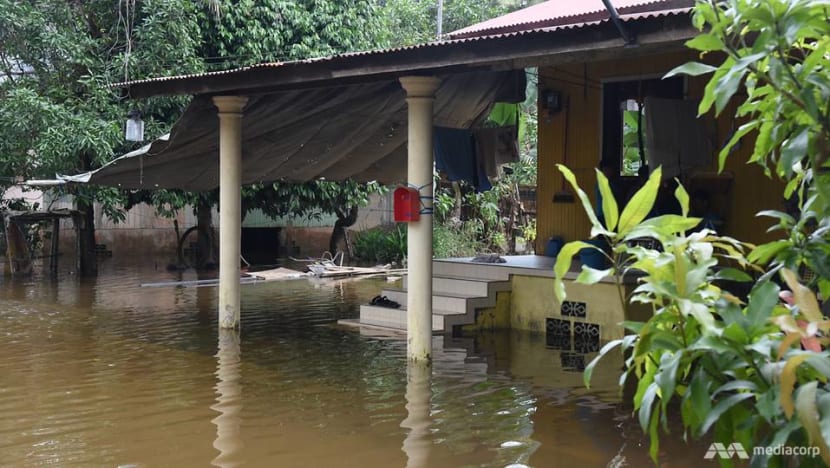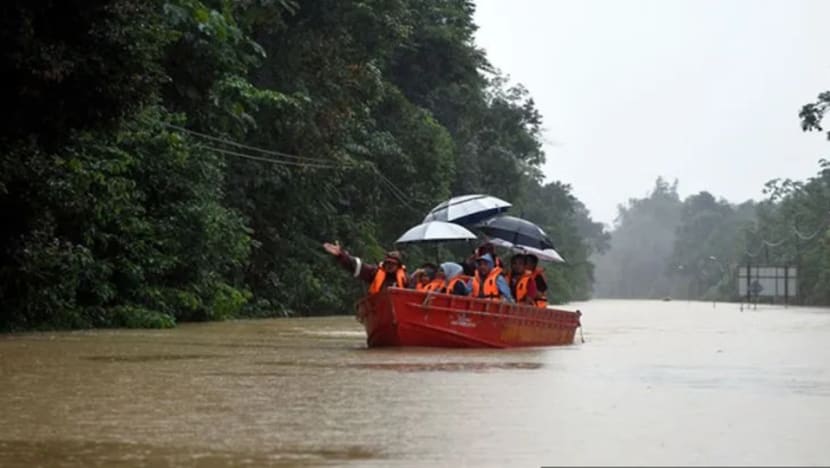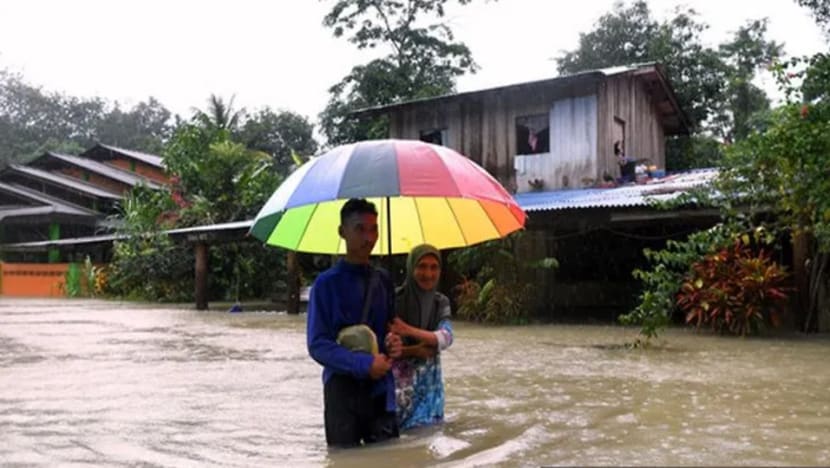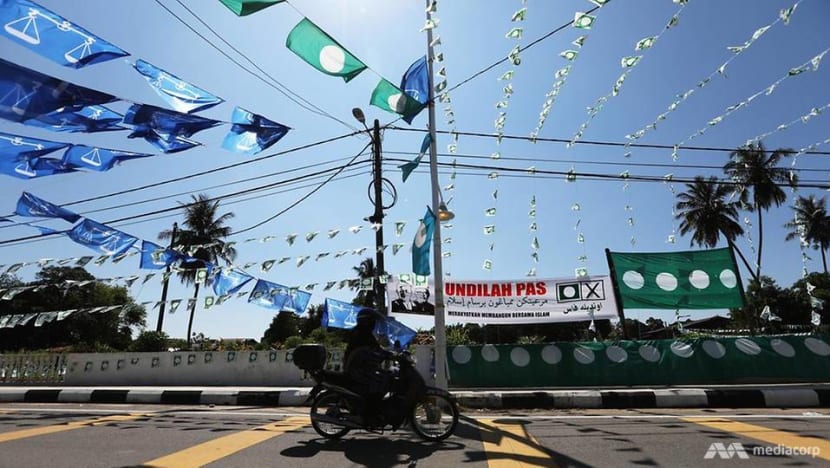commentary Commentary
Commentary: Kelantan’s epic struggles with great, yellow floods each monsoon
With lucrative revenue streams at stake, the state government has little incentive to do more to stop perennial floods, says Serina Abdul Rahman.

A house in Pasir Mas, Kelantan. (Photo: D Kanyakumari)
SINGAPORE: Malaysia saw some of its worst floods in 2014 with Kelantan suffering the brunt of the damage. Some 202,000 people in the state were displaced and 13 died.
Over three days, 1,295mm of rainfall was recorded in Gua Musang - the equivalent of 64 days of rain usually seen in the area.
During the floods, Kelantan’s rivers had risen between 10 to 38m – a serious problem when the official danger point for these rivers’ rise is 9m.
READ: More than 15,000 people affected in Kelantan, Terengganu as flood situation worsens
The inclement weather also severely affected the neighbouring states of Pahang and Terengganu. During the same season, many other areas in Malaysia – including Negeri Sembilan, Johor and Sabah - also suffered floods.
Then-Prime Minister Najib Razak was on holiday in the US and elected not to declare a state of emergency upon his return. But that didn’t stop Malaysian civil society groups from getting swiftly into action to mobilise help for those stranded without food or clean water.
READ: Commentary: The reinvention of Najib Razak, former prime minister of Malaysia
Countless convoys of vans and trucks moved north, packed to the brim with supplies and equipment – a huge uncoordinated NGO and civilian effort that eventually complemented national disaster response teams.
There were also generous foreign contributions of cash, manpower, equipment and emergency rations from Singapore, Japan, Taiwan, China and other concerned neighbours.
PERENNIAL PROBLEM
While the 2014 floods were the worst in Kelantan’s history, such floods have returned each year during the monsoon season.
Significant floods were recorded in 1927 and 1967 in Kelantan. Every year since 2014, heavy rainfall coupled with high tides threaten the return of Bah Kuning (yellow flood) – named so by locals because of the food waters’ high mud content.

While the blame for recurring floods and severe storms usually falls on climate change, the reason for Kelantan’s woes are manifold.
While climate change and global warming have led to more frequent extreme weather phenomena and intensive rainfall over short periods of time, which have the worst impact when tides are high, these issues only serve to enhance the problems peculiar to Kelantan.
READ: Commentary: Extreme weather doesn't change the minds of climate change doubters
Kelantan is one of the least developed and poorest states in Malaysia. There are no gleaming cities of skyscrapers or urban amenities in the state.
Instead, the state is isolated from the rest of the peninsula by the Titiwangsa Mountains; a range that encircles the Kelantan River basin – a fertile rice-bowl that has also historically supported rubber and tobacco plantations.
HUGE LAND ASSETS
Launched in 2006, the Kelantan People’s Farm programme set aside 600,000 ha of forest reserve for monocrop plantations.
It has been argued that a poor state led by an opposition government has little choice but to raise money through the assets that it has.
READ: Cycle of poverty in Malaysia's Kelantan state amid annual floods
Kelantan's oil fields provide revenue to Petronas and the federal government. It has recently filed a lawsuit to claim unpaid oil royalties of about RM1 billion (US$240 million) that could improve infrastructure and alleviate poverty in the state.
Kelantan is also blessed with land and forests. But today, much of the state’s forests, hills and mountains have been razed for oil palm, durian plantations and mining, depriving the state of natural flood prevention features.

Once land, plantation or mining licences are carved out and distributed, forests are logged – this is the first source of income for opportunistic businessmen. Primary forest timber is a goldmine.
Thereafter, the land is stripped and sowed for planting, or dug into for its gold, manganese or iron ore – all of which either result in or require the use of toxic materials to extract desired minerals.
ONE, TWO, THREE, MONSOON
When the monsoon arrives, several things happen.
One, hills bare from logging or mining are no longer able to absorb rainfall and everything slides off mud and clay slopes into the river basin. This is why Kelantan’s floodwaters are yellow.
Two, felled logs stacked by the river banks to be barged to transportation points are sucked into floodwaters and subsequently block river mouths and exit points – forcing water levels to rise.
READ: Harrowing rescue mission for loggers stranded in flooded Kelantan forest
Three, add to that a high tide, and waters rushing down from the hills are met with seawater heading upriver. All of Kelantan’s towns are located in its river basin, adjacent to the rivers that can both support and destroy its communities.
Given that this has now become an annual occurrence, and since it is clear that logging has disastrous consequences on the state’s townships, why isn’t more done to tackle the scourge of flooding?
THE POLITICS OF IT
The Malaysian Meteorological Department is a highly professional entity that accurately predicts extraordinary rainfall and potential flooding well in advance – sending out evacuation warnings to both citizens and other agencies to prepare for adverse conditions.
However, some citizens refuse to pay heed to these warnings and are highly reluctant to evacuate. At times bipartisan tensions prevent immediate and effective disaster response and mitigation.

During the 2014 floods, volunteers on the ground reported that some villagers refused assistance from certain political or religious groups.
Some volunteers who travelled north to help also refused to distribute emergency rations and equipment to areas that were not of political interest to them.
All of these artificially and politically-created divisions get in the way of effective disaster management and response.
Kelantan has always been an opposition state, ruled by the Malaysian Islamic Party (PAS). Distrust and other tensions between the state and the federal government hampers effective collaboration for both disaster relief and habitat conservation.
WHOSE LINE IS IT?
On top of that is the problem of lax local attitudes to waste management. Even during the dry season, when there are no rains to sweep rubbish from land into the rivers and seas, Kelantanese rivers nearest to the townships are already black from pollution and chock full of waste.
There is little proper waste or sanitation systems in some parts of the state.
READ: Commentary: When did Southeast Asia become a dumping ground for waste?
Many citizens also choose to use the drains, streams and rivers as their rubbish bins. All of this waste clogs drainage systems.
When a storm is factored in, waste and logs seal these systems shut – and water levels rise.
In the Malaysian constitution, the federal government is responsible for issues of the environment; including matters of stewardship, conservation and sustainable use of natural resources.

However, jurisdiction over land, water, mining and forests remain with the state. This means that the federal government can only advise the state, but cannot force it to stop logging, mining or clearing hills.
Because licences to mine, plant and log are lucrative sources of income, Kelantan does not seem to be inclined to put a stop to it. The only way that this situation can be improved or mitigated is for regulations in this area to change.
Revisions to the Water Resources Act and the Environmental Quality Act have been discussed, but it is unclear whether revisions can be implemented as state governments will be reluctant to release control over vital sources of income.
READ: Commentary: Grow first, develop later? The pitfalls of measuring economic growth using GDP
But Environment Minister Yeo Bee Yin’s calls for the Malaysian government to be accorded with greater enforcement powers has gained traction since Johor water supplies were disrupted in March after a major pollution incident at Sungai Kim Kim.
Jurisdictional overlaps remain at the heart of the problem. Until this is resolved, Kelantan citizens can only brace themselves for increasingly frequent floods, do what they can to protect their property and belongings, and pay heed to the orders to evacuate.
Dr Serina Abdul Rahman is a Visiting Fellow at the ISEAS – Yusof Ishak Institute.














